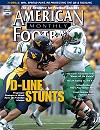AMERICAN FOOTBALL MONTHLY THE #1 RESOURCE FOR FOOTBALL COACHES
Article CategoriesAFM Magazine
|
Offensive Minded: FAU - Mastering the Play Action Passby: Dan Weil© More from this issue Coaching legend Howard Schnellenberger, now heading the program at Florida Atlantic University in Boca Raton, has forged quite a reputation as a master of offensive strategy, particularly passing. We spoke with the coach about his play action attack. He said it is important that the blocking scheme be the same for the passing play as it would be for the running play that is being faked and that the quarterback and running back are convincing in making it look like the play actually will be a run. The Play (See Diagram 1) The play action play favored by Schnellenberger is a sprint draw (6-Texas-104 in FAU’s nomenclature). “We run a draw where the onside tackle and the guard set up for a pass,” the coach said. “The play ac....The full article can only be seen by subscribers. Subscribe today!
|
|
|||||||
| HOME |
MAGAZINE |
SUBSCRIBE | ONLINE COLUMNISTS | COACHING VIDEOS |
Copyright 2025, AmericanFootballMonthly.com
All Rights Reserved





